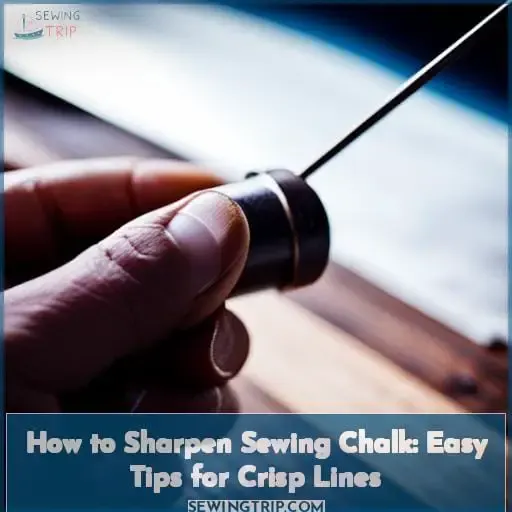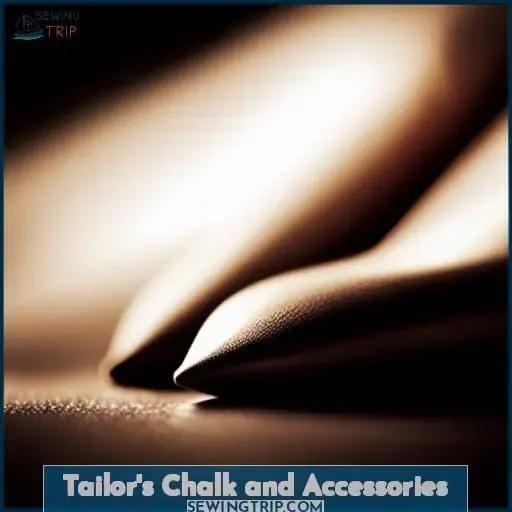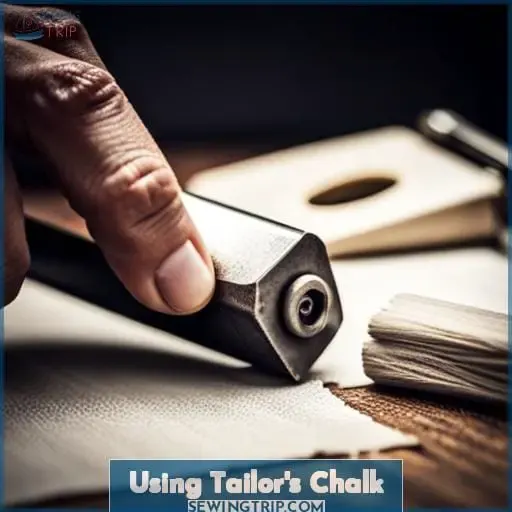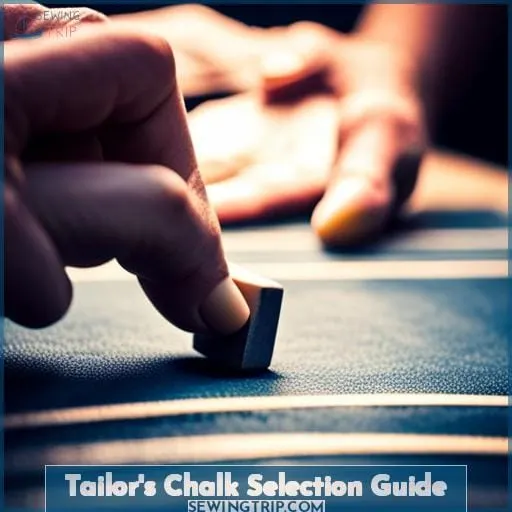This site is supported by our readers. We may earn a commission, at no cost to you, if you purchase through links.
 Ready to master the art of crisp lines in your sewing projects? Discover easy tips on how to sharpen sewing chalk for precise markings. Whether you’re a seasoned seamstress or just starting out, this guide will show you techniques used by expert tailors and seamstresses.
Ready to master the art of crisp lines in your sewing projects? Discover easy tips on how to sharpen sewing chalk for precise markings. Whether you’re a seasoned seamstress or just starting out, this guide will show you techniques used by expert tailors and seamstresses.
Say goodbye to dull edges and hello to clean, sharp lines that make your fabric cutting a breeze.
Table Of Contents
Key Takeaways
- Use a vegetable peeler for sharp chalk edges.
- Chalk holder and sharpener for clean hands.
- Improves control while sharpening.
- Importance of testing chalk on scrap fabric before use.
Using a Vegetable Peeler for Sharpening
To achieve crisp lines and precise marking, consider using a vegetable peeler to sharpen your sewing chalk.
The angled blade of the peeler creates a sharp edge that enhances accuracy in your tailoring work. Additionally, collecting the dust produced while sharpening allows you to replenish your ‘puffer’ or chalk dispenser, reducing the need for frequent purchases and promoting sustainability in your sewing practice.
Benefits of Using a Vegetable Peeler
When sharpening sewing chalk, you can enjoy the benefits of using a vegetable peeler.
- Superior sharpness for precise marking and accuracy.
- Enhances the quality of tailoring work with sharp chalk lines.
- Quick and easy process for sharpening chalk.
Using a vegetable peeler isn’t only cost-effective but also readily available for tailors. Experience the satisfaction of crisp lines in your sewing projects by utilizing this handy tool to maintain your tailor’s chalk.
Replenishing the ‘puffer’ With Chalk Dust
To ensure a continuous supply of chalk for your work, easily replenish the ‘puffer’ with dust collected from sharpening tailor’s chalk using a vegetable peeler.
Reusing chalk dust not only maintains its quality but also promotes eco-friendly practices and sustainability benefits.
Sharpening the chalk creates sharp edges for precise marking, while collecting the dust allows you to refill your puffer as needed.
Protect these precious tools by storing them in cardboard for added longevity and convenience in your sewing accessories collection.
Protecting Chalk With Cardboard
Protect your chalk and extend its lifespan by storing it in cardboard.
- Chalk protection: Cardboard prevents chipping and damage to the edges of the chalk.
- Eco-friendly practices: Collect the dust from sharpening for reuse, reducing waste.
- Chalk storage: By using cardboard, you can easily organize and access your chalk pieces.
Follow these simple steps to protect your cherished sewing tool while contributing to a sustainable approach in your craft.
Tailor’s Chalk and Accessories
When it comes to using tailor’s chalk, having the right accessories can make a world of difference. That’s why investing in a tailor’s chalk holder and sharpener is essential for every seamstress or tailor.
These accessories not only keep your hands clean during marking but also ensure accurate garment marking with crisp lines.
Included Accessories and Features
As you delve into the world of tailor’s chalk, it’s important to consider the accessories and features that come with this essential tool for crisp lines.
The Tailor’s Chalk and Accessories set includes a chalk holder and sharpener, allowing you to keep your hands clean during marking while ensuring accurate garment marking. With one piece of included chalk, this convenient set provides all you need for precise fabric markings.
Enjoy the benefits of sharpening your tailor’s chalk with ease and efficiency.
Benefits of Using a Tailor’s Chalk Holder and Sharpener
For a more efficient and convenient way to sharpen your sewing chalk, consider using a tailor’s chalk holder and sharpener.
Improved Sharpening: A tailor’s chalk holder ensures precise sharpening for crisp lines.
Enhanced Control: The holder provides a comfortable grip, allowing you to maintain control while sharpening.
Versatile Chalk Color Choices: With different colored chalk available, you can easily mark various fabrics without confusion.
Sustainable Option: By investing in a reusable chalk holder, you reduce waste from disposable alternatives.
Master the art of fabric marking with the benefits of using a tailor’s chalk holder and sharpener today!
Using Tailor’s Chalk
When using tailor’s chalk, you’ll find it ideal for marking fabrics accurately and precisely.
It’s commonly used in tailoring and alterations to mark hemlines and adjustments.
Whether you’re working with dark or textured fabrics, tailor’s chalk produces clear and visible lines that are easy to follow.
Ideal Uses and Applications of Tailor’s Chalk
When using tailor’s chalk, it’s important to consider its ideal uses and applications.
Tailor’s chalk offers numerous benefits for marking fabrics in various sewing projects. It produces clear and visible lines, making it suitable for precise garment marking such as hemlines and adjustments.
By selecting the right type of tailor’s chalk based on the fabric being used, you can ensure accurate markings without causing damage or leaving lasting marks. Plus, incorporating eco-friendly practices like sharpening with a vegetable peeler adds sustainability to your sewing routine.
Choosing the Right Chalk for Different Fabrics
To achieve the best results when using tailor’s chalk, it’s important to select the right type of chalk for your specific fabric.
- Consider fabric compatibility when selecting your chalk.
- Different types of tailor’s chalk are available for different fabrics.
- Explore expert recommendations on which type of tailor’s chalk works best with certain materials.
- Use a comprehensive accessories guide to assist you in making an informed decision about your selection.
Tailor’s Chalk Selection Guide
When selecting tailor’s chalk, it’s important to always test it on scrap fabric first to ensure compatibility.
Consider the available colors, materials, and styles of tailor’s chalk as different fabrics may interact differently with marking tools.
If you need guidance on choosing the right tailor’s chalk for your project, don’t hesitate to reach out to our experts who can provide valuable advice.
Importance of Testing on Scrap Fabric
Before you start marking your fabric, it’s crucial to test the tailor’s chalk on a scrap piece of fabric. This step is essential to ensure the effectiveness of the chalk and prevent any unwanted marks or damage on your project.
By testing on scrap fabric, you can gauge how well the chalk transfers onto different materials and determine if adjustments need to be made before working with your actual garment or sewing project.
Available Colors, Materials, and Styles
Now let’s delve into the Tailor’s Chalk Selection Guide, where you can explore the available colors, materials, and styles to find the perfect chalk for your specific fabric needs.
When choosing tailor’s chalk, it’s important to consider different factors such as color preference and fabric compatibility.
From traditional white or blue chalks to more vibrant options like red or yellow, there are various colors available.
Additionally, tailor’s chalk comes in different materials such as clay or wax and a range of styles that cater to individual preferences.
Seek expert guidance for optimal results in your selection process.
Expert Guidance on Chalk Selection
When selecting tailor’s chalk, it’s important to consider the specific needs of your fabric and seek expert guidance for optimal results.
Expert advice can help you navigate the wide range of chalk materials available and guide you in choosing the right one for your project.
They can also provide insights on color options and advise on how to conduct a thorough testing process to ensure that the chosen chalk works well with your fabric type.
Frequently Asked Questions (FAQs)
Can I use a regular pencil sharpener to sharpen tailor’s chalk?
Yes, you can use a regular pencil sharpener to sharpen tailor’s chalk. It provides a quick and efficient way to achieve a precise point for accurate marking on your fabric.
How do I clean the chalk dust from my vegetable peeler?
To clean chalk dust from your vegetable peeler, simply:
- Wipe it off with a damp cloth.
- Rinse it under running water.
Make sure to dry it thoroughly before using again for sharpening your tailor’s chalk.
Can I use sandpaper to sharpen tailor’s chalk?
Yes, you can use sandpaper to sharpen tailor’s chalk.
Gently rub the chalk against fine-grit sandpaper to create a sharp point.
This method ensures precise marking and control over your sewing projects.
Give it a try!
Is there a specific type of fabric that tailor’s chalk works best on?
Tailor’s chalk works best on a variety of fabrics, including cotton, linen, and wool. Its versatility makes it an essential tool for precise markings in your sewing projects.
Are there any alternatives to using a vegetable peeler for sharpening tailor’s chalk?
To sharpen tailor’s chalk, consider using:
- A sandpaper method
- An emery board to file it into a sharp point.
- Alternatively, you can try using a pencil sharpener designed for makeup pencils.
Conclusion
To achieve crisp lines in your sewing projects, mastering the art of sharpening sewing chalk is essential.
By using a vegetable peeler or tailor’s chalk holder and sharpener, you can ensure your chalk is always ready for precise markings.
Tailor’s chalk offers a variety of colors, materials, and styles to suit different fabrics and applications. Remember to test on scrap fabric and seek expert guidance when selecting the right chalk.
Elevate your sewing game with sharp, clean lines that make fabric cutting a breeze.










